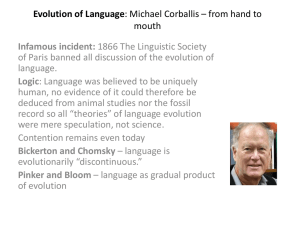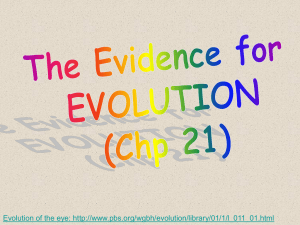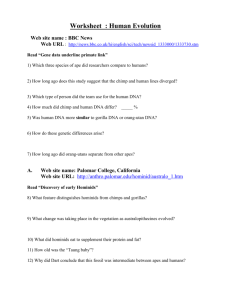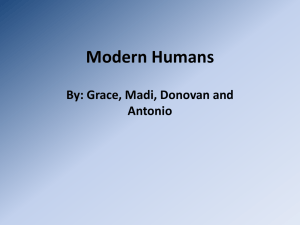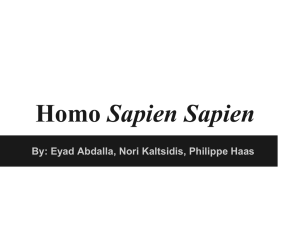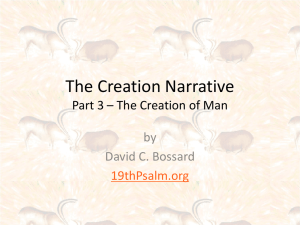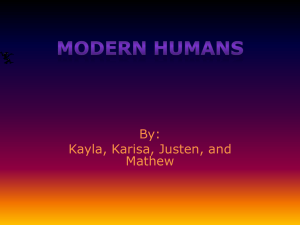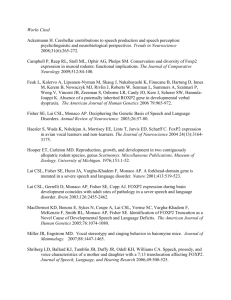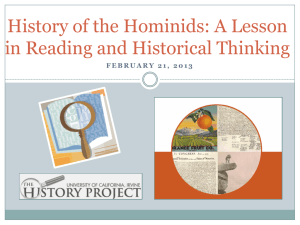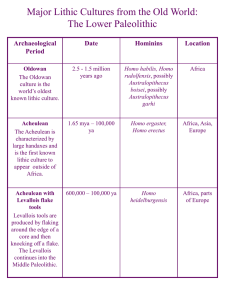Chapter 14: Corballis, M. C. The evolution of language: From hand
advertisement
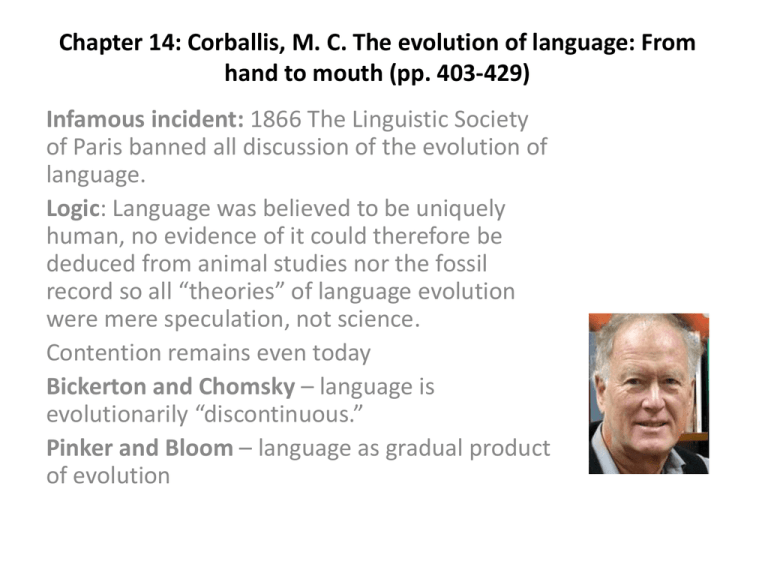
Chapter 14: Corballis, M. C. The evolution of language: From hand to mouth (pp. 403-429) Infamous incident: 1866 The Linguistic Society of Paris banned all discussion of the evolution of language. Logic: Language was believed to be uniquely human, no evidence of it could therefore be deduced from animal studies nor the fossil record so all “theories” of language evolution were mere speculation, not science. Contention remains even today Bickerton and Chomsky – language is evolutionarily “discontinuous.” Pinker and Bloom – language as gradual product of evolution Evolution of Language • Recent findings have largely vindicated an evolutionary approach • Vervet monkey alarm calls – animal signals as referential (symbolic?) • Kanzi studies Evolution of Language • Faculties of Language (Hauser, Fitch & Chomsky, 2002). • Broad sense: communicative capacities shared with animals (reference, simple syntax, etc.) • Narrow sense: recursion • Recursion: The ability to “embed” concepts are routines within each other. • “This is the cat that worried the rat that ate the malt that lay in the house that Jack built.” Ape Language Studies • Washoe Koko Nim Chimpsky • Fouts/Gardners Francine Patterson Herb Terrace Kanzi: The talking Bonobo Sue Savage-Rumbaugh Lexigram symbol language Simple syntax Spontaneous acquisition Referential/symbolic understanding 90% utterances: requests/commands Ape language studies • Lesson: At best this is Protolanguage. • Protolanguage: language without complex syntax, recursion, past/future tense (“grammar”) • Is protolanguage a precursor to “real” language or indicative of a general problem solving ability? – combining symbols to get a reward similar to Sultan combining crates to get food. Proto to “real” language? • Evidence of protolanguage to “real” language evolution • Pidgin to creole studies • Evidence from ontogeny Hominin Evolution • Australopiths: 4.5-1.3mybp bipedal apes, no evidence of requisite cognitive abilities for language • First stone tools – Oldowan Industry 2.5mybp; increased motor control but not cognition • Acheulean Industry and emergence of Homo erectus (1.71.8mybp); more human than ape Brain Evolution • Major increase in brain size around 2mybp with emergence of Homo • Corresponds roughly to deactivation of MYH16 gene which controls jaw muscle growth (2.4mybp) • Corresponds to evidence of mutation in brain regulator gene CMAH, releasing a constraint on brain size (2.1 mybp). • Direct selection pressure for these may have been living in more open territory requiring increased group sizes and cooperation. Life History • Life history as critical to language evolution • Slower post-natal growth period may allow developmental time for language acquisition. • Later Homo species (antecessor; heidelbergensis, 800-500kybp) marks a transition to a more “human-like” pattern of prolonged post-natal development and increased altriciality in infancy. • Elfman’s computer simulation studies: “growth” factor required with degraded “global” inputs for machine to learn grammatical systems. Language from Gesture • Speech should not be consider totality of language; facial expressions, bodily gestures play important semantic role in linguistic communication • Sign language shows all important defining features of language • Primates have far greater voluntary control over limb movements than vocalizations. Fossil Evidence: Late emergence of articulate speech • Evolution of hypoglossal canal: pathway for the hypoglossal nerve (from medulla through hgc to tongue) which is critical for control of tongue. Early hominins had hgc in great ape range, not until Neandertals and Homo sapiens is hgc in modern range. Fossil evidence • Thoracic spinal pathway: important for control of breathing. Again, not in range until Neandertals. • Erectus vertebrae from Asia (l) and Africa Fossil evidence • Shortening of the sphenoid: central bone of cranial base from which face grows. Flattened face may play important role in speech articulation by improving symmetry of vocal tract. Not present in Neandertals, only unique to Homo sapiens branch. Fossil evidence • Neocranial globularity: unique to Homo sapiens; roundness of skull that allows for relative increases in frontal/temporal region of brain (Broca; Wernike areas). Speech as gesture • Speech as gestural system, not acoustic one • Coarticulation problem: Phonemes exist in the mind, not in acoustic signal. • Articulatory phonology: Speech as fundamentally a set of articulatory gestures from mouth, tongue, face, and body. Mirror Neurons: connecting perception and production • Role of mirror neurons: neurons in premotor cortex that respond not just to action but to watching an action. Neural link between perception and production of action. Mirror neurons located in area F5 of monkey brain which appears to be analogous to Broca’s area in human brain – close connection between perception/control of motor movements and evolution of speech. FOXP2: Gene for articulation? • Role of the FOXP2 gene: may be important for speech articulation. Important mutation in FOXP2 appears to have arisen sometime between 100,000 – 10,000 ybp. • Possibility that “click” languages found in some Africa traditional societies and (extinct) aboriginal Australian represent a way of adding sound to facial gesture prior to FOXP2 mutation. Summary • Advantages of speech over gesture-based language: Frees hands for tool use and manufacture May allow for greater working memory capacity and therefore more complex expressions Less attentionally demanding • Evolutionary scenario: 2mybp: emergence of more complex grammar, associated with bigger brains (protolanguage) 100,000 move from proto to real language with FOXP2 mutation, extended infant/childhood maturation period
